
Bivalvia, in previous centuries referred to as the Lamellibranchiata and Pelecypoda, is a class of marine and freshwater molluscs that have laterally compressed bodies enclosed by a shell consisting of two hinged parts. Bivalves as a group have no head and they lack some usual molluscan organs like the radula and the odontophore. They include the clams, oysters, cockles, mussels, scallops, and numerous other families that live in saltwater, as well as a number of families that live in freshwater. The majority are filter feeders. The gills have evolved into ctenidia, specialised organs for feeding and breathing. Most bivalves bury themselves in sediment where they are relatively safe from predation. Others lie on the sea floor or attach themselves to rocks or other hard surfaces. Some bivalves, such as the scallops and file shells, can swim. The shipworms bore into wood, clay, or stone and live inside these substances.

The cownose ray is a species of eagle ray found throughout a large part of the western Atlantic and Caribbean, from New England, United States to southern Brazil. Male rays often reach about 2 and 1/2 feet in width. Females typically reach about 3 feet in width. However, there have been reports of rays up to 7 feet in width. Sizes change depending on the geographical range. Females will usually grow larger than males, allowing for larger offspring. These rays also belong to the order Myliobatiformes, a group that is shared by bat rays, manta rays, and eagle rays.

A siphon is an anatomical structure which is part of the body of aquatic molluscs in three classes: Gastropoda, Bivalvia and Cephalopoda.

The Pacific razor clam, Siliqua patula, is a species of large marine bivalve mollusc in the family Pharidae.
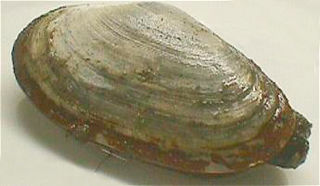
Soft-shell clams or sand gaper, scientific name Mya arenaria, popularly called "steamers", "softshells", "piss clams", "Ipswich clams", or "Essex clams" are a species of edible saltwater clam, a marine bivalve mollusk in the family Myidae.
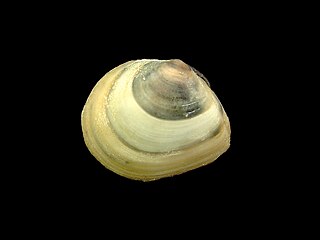
Limecola balthica, commonly called the Baltic macoma, Baltic clam or Baltic tellin, is a small saltwater clam, a marine bivalve mollusk in the family Tellinidae.

The razor shell, Ensis magnus, also called razor clam, razor fish or spoot (colloquially), is a bivalve of the family Pharidae. It is found on sandy beaches in northern Europe.
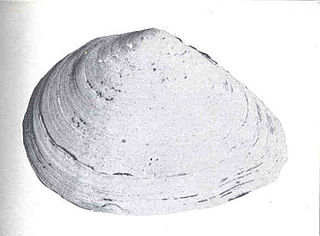
Macoma nasuta, commonly known as the bent-nosed clam, is a species of bivalve found along the Pacific Ocean coast of North America. It is about 6 cm (2.4 in) long. It is often found buried in sands of 10–20 cm (3.9–7.9 in) in depth. This rounded clam has no radial ribs. Archaeological data supports the use of this species by Native Americans such as the Chumash peoples of central California.

Venerupis philippinarum is an edible species of saltwater clam in the family Veneridae, the Venus clams.
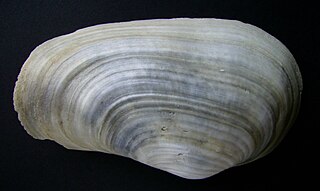
Panopea zelandica, commonly known as the deepwater clam or New Zealand geoduck, is a large species of marine bivalve mollusc in the Panopea (geoduck) genus of the family Hiatellidae. It is also sometimes called a king clam, or a gaper – in reference to the shell not being closed at either end.

Mya truncata, common name the blunt gaper or truncate softshell, is a species of edible saltwater clam, a marine bivalve mollusk in the family Myidae.
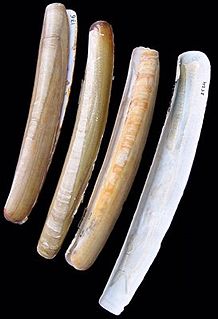
Ensis ensis, or the sword razor, is a razor clam, a marine bivalve mollusc in the family Pharidae. It lives buried in the sand and is found off the coasts of northwest Europe.
Abarenicola pacifica or the Pacific lugworm is a large species of polychaete worm found on the west coast of North America and also in Japan. The worms live out of sight in burrows under the sand and produce casts which are visible on the surface.
Phaxas pellucidus, the transparent razor shell, is a species of marine bivalve mollusc in the family Pharidae. It is found buried in the seabed in coastal waters of northwest Europe, often in great numbers.

Cyrtopleura costata, or the angel wing clam, is a bivalve mollusc in the family Pholadidae. It is found in shallow parts of the northwest Atlantic and also in the North Sea of Scotland coastline and west coast of the Adriatic Sea by a remote area in the Marche region in central Italy, living in the seabed, where it digs its burrows on a very slow revolving movement for years through soft sand and mud always to a max depth of 8ft but always below 3 feet (0.91 m) at the lowest tide.

Mulinia lateralis, the dwarf surf clam or coot clam, is a species of small saltwater clam, a bivalve mollusc in the family Mactridae. It occurs in the western Atlantic Ocean and the Caribbean Sea.
Laternula elliptica is a species of saltwater clam, a marine bivalve mollusc in the family Laternulidae, the lantern shells. It is the largest bivalve found under the surface of the seabed in the Southern Ocean.

Tresus nuttallii, common name the Pacific gaper, is a species of saltwater clam, a marine bivalve mollusk in the family Mactridae. It also shares the common name horse clam with Tresus capax, a species which is similar in morphology and lifestyle. Both species are somewhat similar to the Geoduck, though smaller, with shells up to eight inches long (20 cm), weight to 3–4 lb (1.4–1.8 kg).

Venerupis corrugata, the pullet carpet shell, is a species of bivalve mollusc in the family Veneridae. It is found buried in the sediment on the sea bed in shallow parts of the eastern Atlantic Ocean. It is harvested for human consumption in Spain and other parts of Western Europe.

Solecurtus strigilatus, also known as the rosy razor clam, is a species of saltwater clam, a marine bivalve mollusc in the family Solecurtidae. This mollusc is a suspension feeder and can burrow with great rapidity to escape predators. It is an unusual bivalve in that its shell valves are too small to contain all the soft tissue, and the animal is unable to retreat into its shell.
















